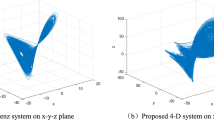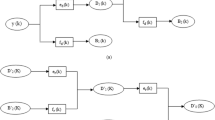Abstract
In order to further improve the transmission and spectral efficiency of the MC-DCSK system, a novel security system called Joint Mapping Multi-Carrier Differential Chaos Shift Keying (JM-MC-DCSK) is proposed in this paper. A novel joint mapping scheme is designed which consists of two parts: matrix reshaping mapping and combination mapping. Moreover, in order to correctly demodulate the information bits in the index obtained through Maximum Likelihood Estimation (MLE), we propose a new index mapping algorithm to match this joint mapping scheme. The information bits are first mapped into U mutually orthogonal matrices in the matrix reshaping mapping structure. In this structure, we employ segmental shifts of the orthogonal submatrices instead of cyclic shifts to eliminate intra-signal interference, which contributes to the reliability of the system. Then, in the combination mapping structure, the information bits are modulated by N orthogonal carriers after being replicated U times. In each carrier signal, we arbitrarily select two sequences from the U orthogonal chaotic sequences to be superimposed. This scheme can map more information symbols and the randomness of the combination selection provides more flexibility for the mapping algorithm. The Bit Error Rate is derived and analyzed under Additive White Gaussian Noise and Rayleigh Fading Channel by Gaussian approximation method and central limit theorem, and numerical simulations are conducted to verify the correctness of theory. Additionally, the simulation results demonstrate that the system also has lower BER and Peak-to-Average Power Ratio, reflecting its significant theoretical and practical engineering value.














Similar content being viewed by others
Data and code availability
Availability of data and materials no data
Code Availability
Not applicable
References
Chen, Z., Zhang, L., Zhang, J., Wu, Z., & Luobu, D. (2022). An ofdm-based pre-coded chaos shift keying transceiver for reliable v2v transmission. IEEE Transactions on Vehicular Technology, 71, 6710–6715.
Hu, W., Wang, L., & Kaddoum, G. (2017). Design and performance analysis of a differentially spatial modulated chaos shift keying modulation system. IEEE Transactions on Circuits and Systems II: Express Briefs, 64, 1302–1306.
Cheng, G., Wang, L., Xu, W., & Chen, G. (2016). Carrier index differential chaos shift keying modulation. IEEE Transactions on Circuits and Systems II: Express Briefs, 64, 907–911.
Zhang, G., Xu, K., & He, L. (2021). Orthogonal multiuser short reference high rate differential chaos shift keying communication system. Journal of Electronics and Information Technology, 43, 3131–3140.
Liu, Z., Zhang, L., Wu, Z., & Bian, J. (2019). A secure and robust frequency and time diversity aided ofdm-dcsk modulation system not requiring channel state information. IEEE Transactions on Communications, 68, 1684–1697.
Taleb, F., Bendimerad, F. T., & Roviras, D. (2016). Very high efficiency differential chaos shift keying system. IET Communications, 10, 2300–2307.
Quyen, N. X. (2017). On the study of a quadrature dcsk modulation scheme for cognitive radio. International Journal of Bifurcation and Chaos, 27, 1750135.
Kaddoum, G., Richardson, F.-D., & Gagnon, F. (2013). Design and analysis of a multi-carrier differential chaos shift keying communication system. IEEE Transactions on Communications, 61, 3281–3291.
Cai, X., Xu, W., Hong, S., & Wang, L. (2020). A trinal-code shifted differential chaos shift keying system. IEEE Communications Letters, 25, 1000–1004.
He, L., Wu, X., & Zhang, T. (2021). Quadrature multicarrier noise reduction differential chaos shift keying system. Journal of Electronics and Information Technology, 43, 1120–1128.
Yang, H., Jiang, G.-P., Tang, W. K., Chen, G., & Lai, Y.-C. (2017). Multi-carrier differential chaos shift keying system with subcarriers allocation for noise reduction. IEEE Transactions on Circuits and Systems II: Express Briefs, 65, 1733–1737.
Xiaohui, L., Xiaoting, C., et al. (2020). Short-reference m-ary security differential chaos shift keying system. Systems Engineering and Electronics, 42, 2899–2905.
Ma, H., Cai, G., Fang, Y., Chen, P., & Chen, G. (2019). Design of a superposition coding ppm-dcsk system for downlink multi-user transmission. IEEE Transactions on Vehicular Technology, 69, 1666–1678.
He, L., Dong, J., & Zhang, G. (2022). Design and performance analysis of orthogonal multi-user cd-dcsk scheme. Journal of Electronics and Information Technology, 44, 1–11.
Liu, Z., Zhang, L., & Chen, Z. (2018). Low papr ofdm-based dcsk design with carrier interferometry spreading codes. IEEE Communications Letters, 22, 1588–1591.
Cai, X., Xu, W., Hong, S., & Wang, L. (2021). Discrete w transform based index-keying m-ary dcsk for non-coherent chaotic communications. IEEE Communications Letters, 25, 3104–3108.
Cai, X., Xu, W., & Wang, L. (2022). Design of divide-and-conquer noise decontamination strategy for m-ary dcsk: From remodulation to denoising. IEEE Communications Letters, 26, 1673–1677.
Lin, Z., Xu, W., Sun, H., & Wang, L. (2023). A hybrid dcsk scheme combining cyclic shift keying and code index modulation. IEEE Communications Letters, 27, 2303–2307.
Chen, Z., Zhang, L., Wang, W., & Wu, Z. (2022). A pre-coded multi-carrier m-ary chaotic vector cyclic shift keying transceiver for reliable communications. IEEE Transactions on Wireless Communications, 21, 1007–1021.
Zhang, G., He, P. & He, L. (2023). Multi-carrier multi-level dcsk communication system based on time-reversal. Annals of Telecommunications, 1–13.
Quyen, N. X. (2018). Multi-carrier differential chaos-shift keying with repeated spreading sequence. Journal of Communications and Networks, 20, 299–308.
Chen, Z., Zhang, L., & Wu, Z. (2020). High data rate discrete-cosine-spreading aided m-ary differential chaos shift keying scheme with low papr. IEEE Transactions on Circuits and Systems II: Express Briefs, 67, 2492–2496.
Liu, Z., Zhang, L., Wu, Z., & Jiang, Y. (2020). Energy efficient parallel concatenated index modulation and \(m\)-ary psk aided ofdm-dcsk communications with qos consideration. IEEE Transactions on Vehicular Technology, 69, 9469-9482.
Holla K. N., Sudha, K. L., Shakya, S., Bestak, R., Palanisamy, R., & Kamel, K. A. (Eds.), Ber performance comparison between different combinations of stbc and dcsk of independent samples and bits of message signal. (eds Shakya, S., Bestak, R., Palanisamy, R. & Kamel, K. A.) Mobile Computing and Sustainable Informatics, 555–567 (Springer, Singapore, 2022).
Zhang, G., Lai, R., & Jiang, Z. (2023). A noise reducing multi-carrier dcsk communication system based on carrier phase and code index modulation. Wireless Personal Communications, 1–22.
Fan, Y., & Zhang, J. (2009). Narrowband interference cancellation based on set-membership estimation in dcsk communication system. Signal Processing, 89, 1661–1666.
Liu, Z., So, H. C., Zhang, L., & Li, X. P. (2021). Robust receiver for ofdm-dcsk modulation via rank-1 modeling and \(\ell \) p-minimization. Signal Processing, 188, 108219.
Chen, H., Chen, P., Wang, S., Lai, S., & Chen, R. (2022). Reference-modulated pi-dcsk: A new efficient chaotic permutation index modulation scheme. IEEE Transactions on Vehicular Technology, 71, 9663–9673.
Dou, X., Chen, X., Liang, D., & Lin, B. (2021). A time-delay overlapping modulation-based high spectral efficiency and secure dcsk system. IEEE Access, 9, 122685–122695.
Cai, X., Xu, W., Wang, L., & Kolumbán, G. (2019). Multicarrier \( m \)-ary orthogonal chaotic vector shift keying with index modulation for high data rate transmission. IEEE Transactions on Communications, 68, 974–986.
Cai, X., Xu, W., Wang, L., & Kaddoum, G. (2022). Joint energy and correlation detection assisted non-coherent ofdm-dcsk system for underwater acoustic communications. IEEE Transactions on Communications, 70, 3742–3759.
Tao, Y., Fang, Y., Ma, H., Mumtaz, S., & Guizani, M. (2022). Multi-carrier dcsk with hybrid index modulation: a new perspective on frequency-index-aided chaotic communication. IEEE Transactions on Communications, 70, 3760–3773.
Zhang, G., Zhao, C., & Zhang, T. (2020). Performance analysis of miso-mu-ohe-dcsk system over Rayleigh fading channels. AEU-International Journal of Electronics and Communications, 115, 153048.
Acknowledgements
This work is supported by the National Natural Science Foundation of China (No. 61771085), Research Project of Chongqing Educational Commission (KJ1600407, KJQN201900601).
Funding
This work is supported by the National Natural Science Foundation of China (No. 61771085), Research Project of Chongqing Educational Commission (KJ1600407, KJQN201900601).
Author information
Authors and Affiliations
Contributions
LH Conceptualization, Writing—Review and Editing, Funding acquisition RL Software, Validation, Writing—Original SS Methodology, Supervision, Project administration
Corresponding author
Ethics declarations
Conflict of interest
The authors declare that they have no known competing financial interests or personal relationships that could have appeared to influence the work reported in this paper.
Ethical standard
Not applicable
Consent to participate
I understand that my participation is voluntary and I agree it
Consent for publication
Not applicable
Additional information
Publisher's Note
Springer Nature remains neutral with regard to jurisdictional claims in published maps and institutional affiliations.
Rights and permissions
Springer Nature or its licensor (e.g. a society or other partner) holds exclusive rights to this article under a publishing agreement with the author(s) or other rightsholder(s); author self-archiving of the accepted manuscript version of this article is solely governed by the terms of such publishing agreement and applicable law.
About this article
Cite this article
He, L., Lai, R. & Shao, S. A novel joint mapping scheme design with low PAPR aided differential chaos shift keying system. Telecommun Syst (2024). https://doi.org/10.1007/s11235-024-01122-9
Accepted:
Published:
DOI: https://doi.org/10.1007/s11235-024-01122-9




